Second Law Analysis of a Mobile Air Conditioning System with Internal Heat Exchanger Using Low GWP Refrigerants
Abstract
:1. Introduction
2. Theoretical Analysis
2.1. Scheme Description
- To allow certain excess amounts of liquid supply to the evaporator in order to simplify the control system and enhance heat transfer;
- To withdraw or to deliver extra charge of refrigerant for the regulation of the high side pressure by means of the throttling valve;
- To hold a sufficient amount of liquid to cover the needs under all possible working conditions and to compensate unavoidable losses by leakage over a reasonable time;
- To introduce suitable amount of lubricant into the compressor by means of either a capillary tube or throttling valve to the suction line;
- To provide sufficient gas volume to avoid excessive build-up pressure when the plant is idle at extremely high room temperature.
2.2. Operational Scheme Conditions
2.3. Energy and Exergy Analysis
- -
- Isentropic efficiency of the compressor;
- -
- Isenthalpic expansion;
- -
- Pressure drops in all the connecting pipes and heat transfer between the connecting pipes and the environment are negligible.
3. Results
3.1. Superheating and Sub-Cooling Influence
3.2. Evaporating and Condensing Temperature Influence
3.3. Isentropic Efficiency and Effectiveness IHX Influence
4. Conclusions
- Considering the point at which the maximum entropy production is reached in the IHX, the use of R1234yf is recommended for a super-heating degree above 8.5 K, since it is at this point where second law efficiency reaches its highest possible value, the above, when no sub-cooling is present.
- The mobile air conditioning system using R1234ze is found to be most efficient than the other refrigerants, because its performance is similar to R134a, even with the integration of the IHX. In fact, it is more efficient than the R152 when the effectiveness is up to 70%.
- The sub-cooling and superheating effect is a considerable variable in the efficiency by Second Law because, with this parameter, the second law efficiency of the system increases, improving mainly R1234yf.
- Although R152a shows better exergy performance, this refrigerant is not recommended as a drop-in replacement due to its high flammability. The use of this refrigerant is only recommended when used in a secondary loop.
- Influence of isentropic efficiency on the system exhibits the maximum exergy destruction on the compressor and in the condenser for all refrigerant options, including R134a.
- By the use of IHX in the system, second law efficiency increased for all refrigerants. The best performance is found using R152a and worst performance is observed using R1234yf.
Acknowledgments
Author Contributions
Conflicts of Interest
Subscripts
| COP | Coefficient of performance |
| e | Specific exergy (kJ/kg) |
| h | Specific enthalpy (kJ/kg) |
| q | Specific heat (kJ/kg) |
| s | Specific entropy (kJ/kg K) |
| T | Temperature (K) |
| W | Specific compressor work (kJ/kg) |
Subscripts
| c | Compressor |
| 1,2,3,…6 | Thermodynamic states |
| 0 | Reference state |
| H | Outdoor |
| L | Indoor |
| sc | Sub-cooling |
| sh | Superheating |
| exp | Expansion device |
| con | Condenser |
| ev | Evaporator |
| IHX | Internal heat exchanger |
| R | Reversible process |
| sys | System |
| sup | Supplied |
| rec | Recovery |
| eq | Equipment |
Greek Symbols
| ε | IHX effectiveness |
| η | Isentropic efficiency |
| Δ | Losses (kJ/kg K) |
| χ | Second Law Efficiency |
| δ | Specific entropy generated (kJ/kg K) |
| Ψ | Relative exergy destruction |
| σ | Exergetic efficiency system |
References
- UNEP. HFCs: A Critical Link in Protecting Climate and the Ozone Layer—A Synthesis Report; UNEP: Nairobi, Kenya, 2011. [Google Scholar]
- Regulation, EU No 517/2014 of the European Parliament and the Council of 16 April 2014 on Fluorinated Greenhouse Gases and Repealing Regulation (EC) No 842/2006. Available online: http://www.eea.europa.eu/policy-documents/regulation-eu-no-517-2014 (accessed on 18 April 2017).
- Brown, J.S. Introduction to hydrofluoro-olefin alternatives for high global warming potential hydrofluorocarbon refrigerants. HVAC&R Res. 2013, 19, 693–704. [Google Scholar]
- Kedzierski, M.A.; Brown, J.S.; Koo, J. Performance ranking of refrigerants with low global warming potential. Sci. Technol. Built Environ. 2015, 21, 207–219. [Google Scholar] [CrossRef]
- Bryson, M.; Dixon, C.; StHill, S. Testing of HFO-1234yf and R152a as mobile air conditioning refrigerant replacements. Ecolibrium 2011, 2011, 30–38. [Google Scholar]
- Molés, F.; Navarro-Esbrí, J.; Peris, B.; Mota-Babiloni, A.; Barragán-Cervera, A. Theoretical energy performance evaluation of different single stage vapour compression refrigeration configurations using R1234yf and R1234ze(E) as working fluids. Int. J. Refrig. 2014, 44, 141–150. [Google Scholar] [CrossRef]
- Jignesh, G.; Rangesh, K. Thermodynamic cycle analysis of mobile air conditioning system using HFO-1234yf as an alternative replacement of HFC-134a. Int. J. Sci. Eng. Technol. Res. 2016, 5, 234–247. [Google Scholar]
- Lee, Y.; Jung, D. A brief performance comparison of R1234yf and R134a in a bench tester for automobile applications. Appl. Therm. Eng. 2012, 35, 240–242. [Google Scholar] [CrossRef]
- Zhao, Y.; Chen, J.; Xu, B.; He, B. Performance of R-1234yf in mobile air conditioning system under different heat load conditions. Int. J. Air Cond. Ref. 2012, 20, 1250016. [Google Scholar] [CrossRef]
- Zhao, Q. Performance improvements potentials of R1234yf mobile air conditioning system. Int. J. Refrig. 2015, 58, 35–40. [Google Scholar]
- Zilio, C.; Brown, J.S.; Schiochet, G.; Cavallini, A. The refrigerant R1234yf in air conditioning systems. Energy 2011, 36, 6110–6120. [Google Scholar] [CrossRef]
- Navarro-Esbrí, J.; Mendoza-Miranda, J.M.; Mota-Babiloni, A.; Barragán-Cervera, A.; Belman-Flores, J.M. Experimental analysis of R1234yf as a drop-in replacement for R134a in a vapor compression system. Int. J. Refrig. 2013, 36, 870–880. [Google Scholar] [CrossRef]
- Gomaa, A. Performance Characteristics of Automotive Air Conditioning System with Refrigerant R134a and its Alternatives. Int. J. Energy Power Eng. 2015, 50, 168–177. [Google Scholar] [CrossRef]
- Yataganbaba, A.; Kilicarslan, A.; Kurtbas, I. Exergy analysis of R1234yf and R1234ze as R134a replacement in a two evaporator vapour compression refrigeration system. Int. J. Refrig. 2015, 60, 26–37. [Google Scholar] [CrossRef]
- Özgür, A.E.; Kabul, A.; Önder, K. Exergy analysis of refrigeration systems using an alternative refrigerant (hfo1234yf) to R-134a. Int. J. Low Carbon Technol. Adv. Access 2012, 9, 1–7. [Google Scholar]
- Cho, H.; Park, C. Experimental investigation of performance and exergy analysis of automotive air conditioning systems using refrigerant R1234yf at various compressor speeds. App. Therm. Eng. 2016, 101, 30–37. [Google Scholar] [CrossRef]
- Pottker, G.; Hrnjak, P. Experimental investigation of the effect of condenser subcooling in R134a and R1234yf air-conditioning systems with and without internal heat exchanger. Int. J. Refrig. 2015, 50, 104–113. [Google Scholar] [CrossRef]
- Golzari, S.; Kasaeian, A.; Daviran, S.; Mahian, O.; Wongwises, S.; Sahin, A.Z. Second Law analysis of an automotive air conditioning system using HFO-1234yf, an environmentally friendly refrigerant. Int. J. Refrig. 2017, 73, 134–143. [Google Scholar] [CrossRef]
- Bilen, K.; Kalkisim, A.T.; Solmus, I. The performance of an alternative refrigerant gas R152a as mobile air conditioning refrigerant. Chem. Eng. Trans. 2014, 39, 1801–1806. [Google Scholar]
- Jignesh, K.V.; Ragesh, G.K. A brief literature survey on an Automobile Air-Conditioning System. Int. J. Eng. Dev. Res. 2014, 2, 558–570. [Google Scholar]
- Subiantoro, A.; Ooi, T.K.; Stimming, U. Energy Saving Measures for Automotive Air Conditioning (AC) System in the Tropics. In Proceedings of the 15th International Refrigeration and Air Conditioning Conference at Purdue, West Lafayette, IN, USA, 14–17 July 2014. [Google Scholar]
- Herold, K.E. Performance limits for the thermodynamics cycles. Adv. Heat Pumps 1989, 7, 15–22. [Google Scholar]
- Krakow, K.I. Relationships between Irreversibility, Exergy Destruction, and Entropy Generation for Systems and Components. Available online: http://www.techstreet.com/standards/3735-relationships-between-irreversibility-exergy-destruction-and-entropy-generation-for-systems-and-components?product_id=1716402 (accessed on 18 April 2017).
- Fartaj, A.; Ting, D.S.K.; Yang, W.W. Second Law analysis of the transcritical CO2 refrigeration cycle. Energy Convers. Manag. 2004, 45, 2269–2281. [Google Scholar] [CrossRef]
- Dincer, I.; Rosen, M.A. Exergy: Energy, Environment and Sustainable Development; Elsevier: Amsterdam, The Netherlands, 2007. [Google Scholar]
- Kabeel, A.E.; Khalil, A.; Bassuoni, M.M.; Raslan, M.S. Comparative experimental study of low GWP alternative for R134a in a walk-in cold room. Int. J. Refrig. 2016, 69, 303–312. [Google Scholar] [CrossRef]
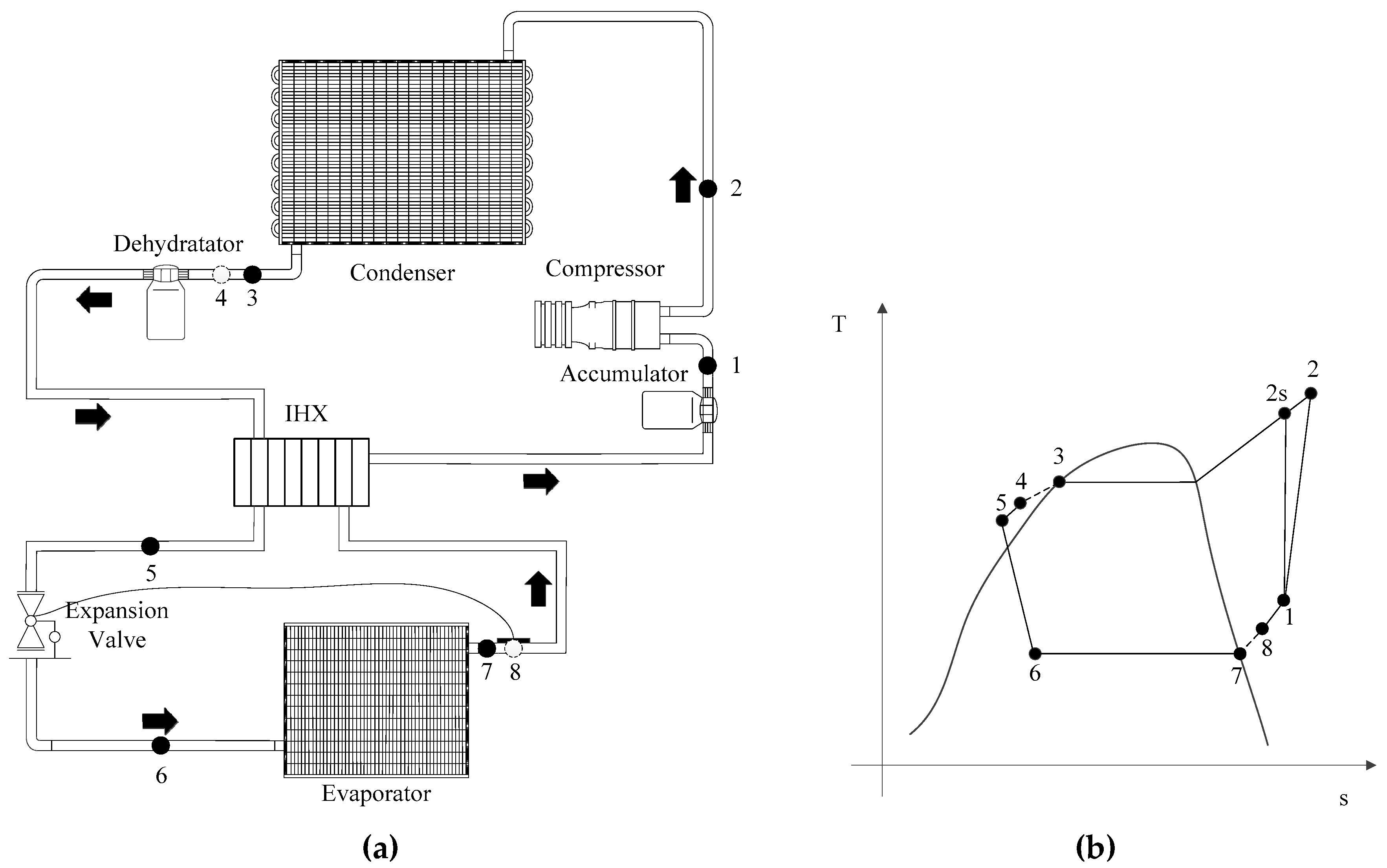
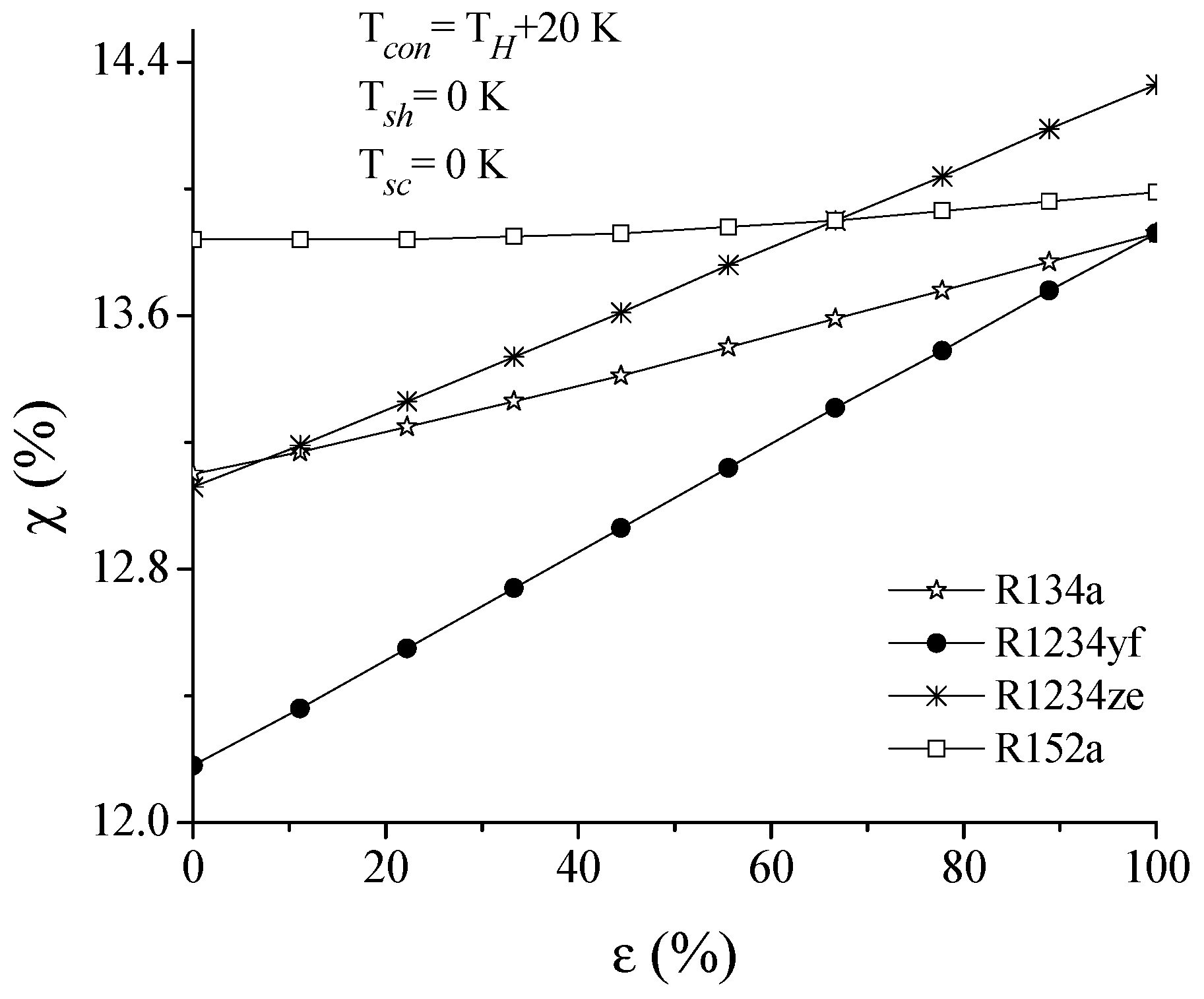
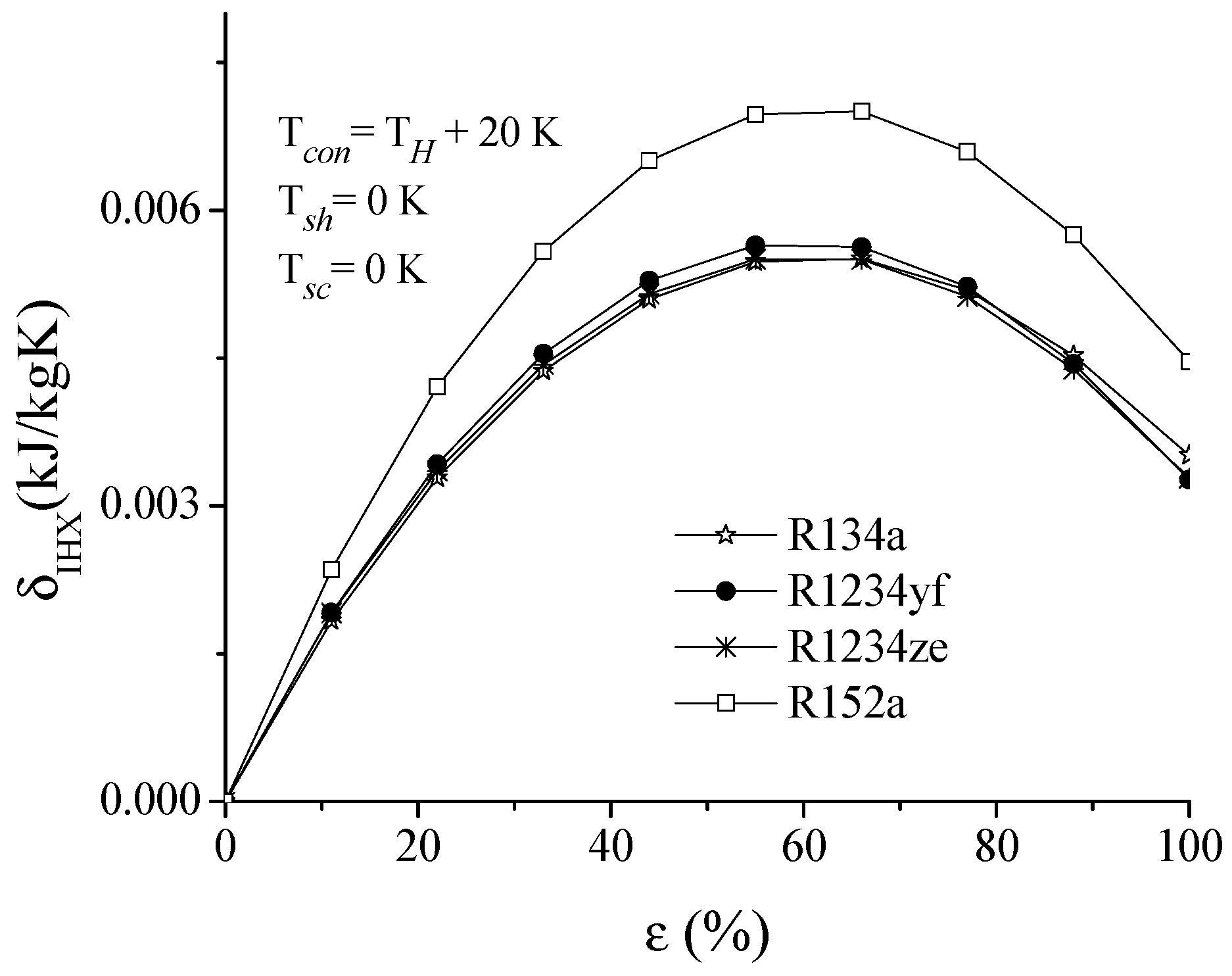
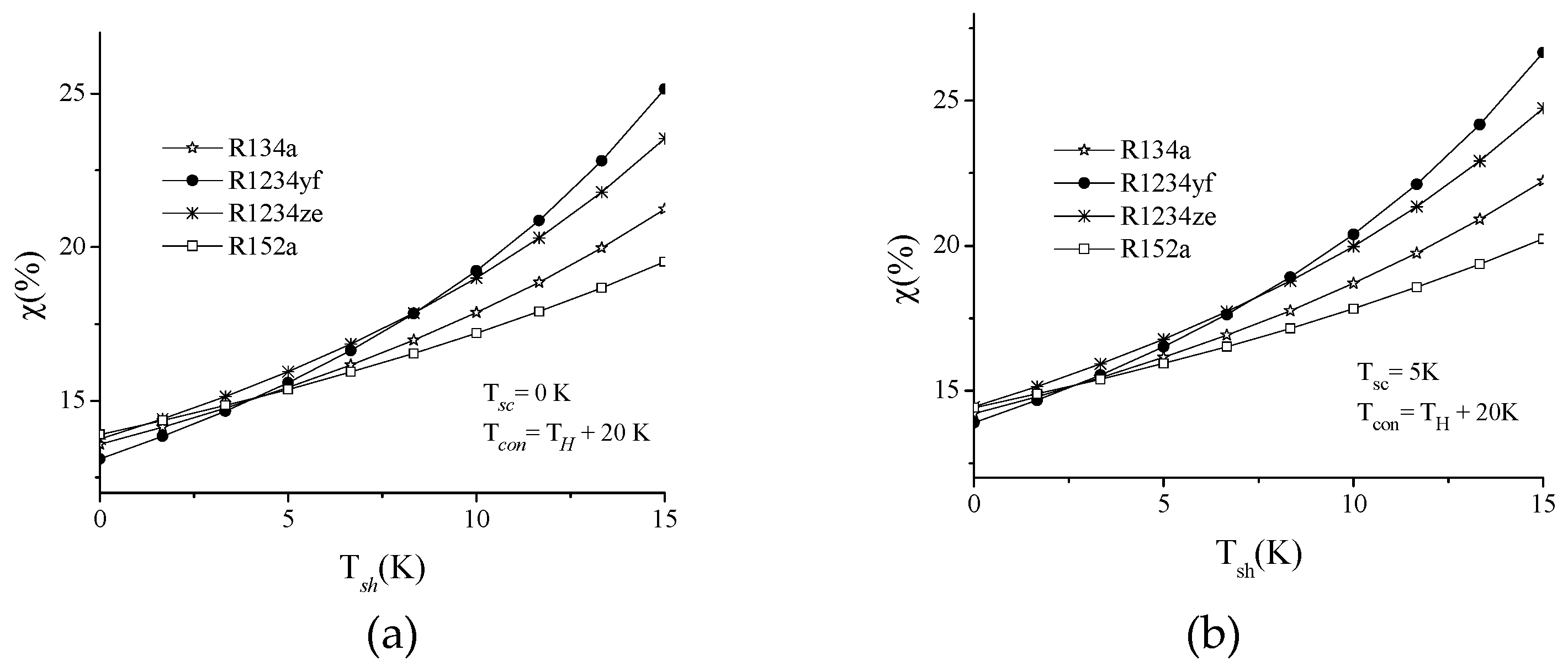
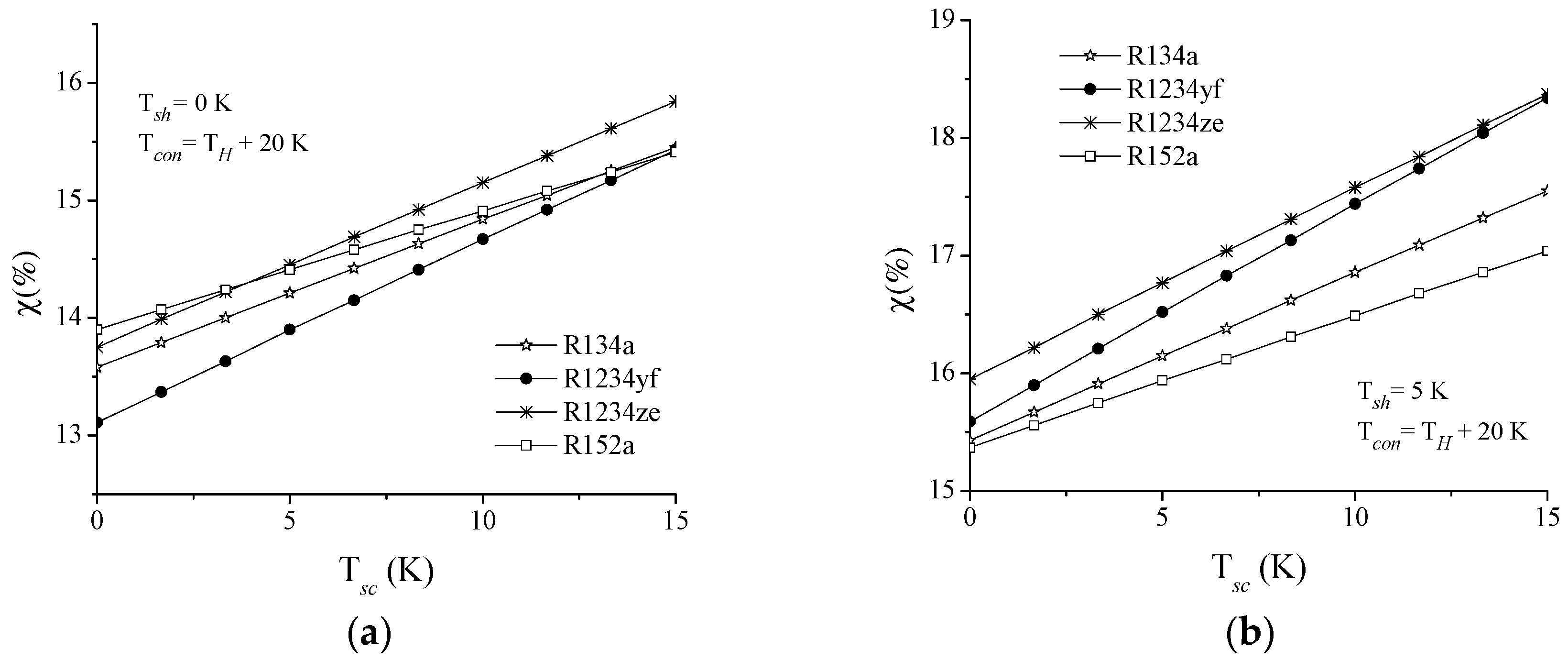
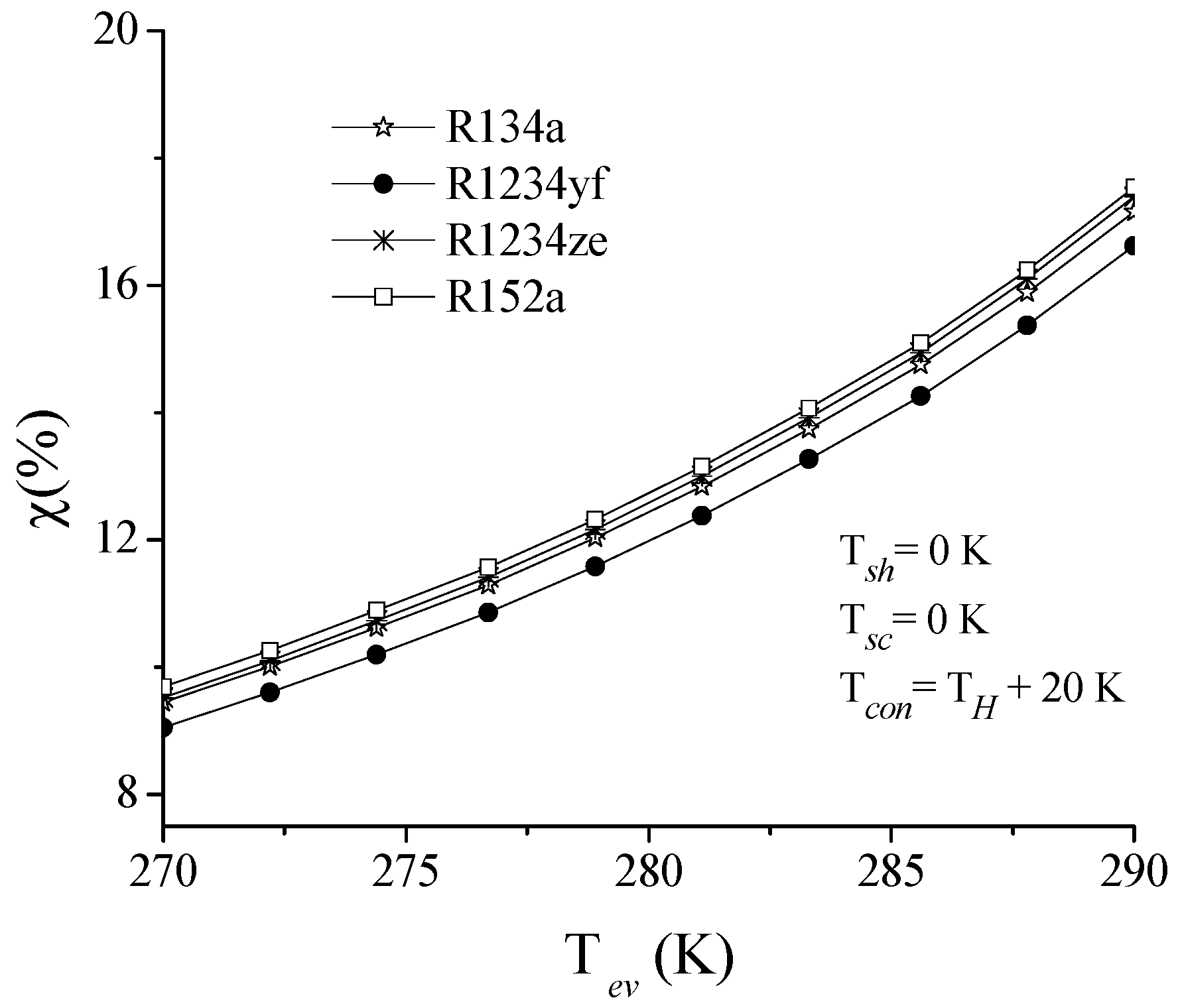

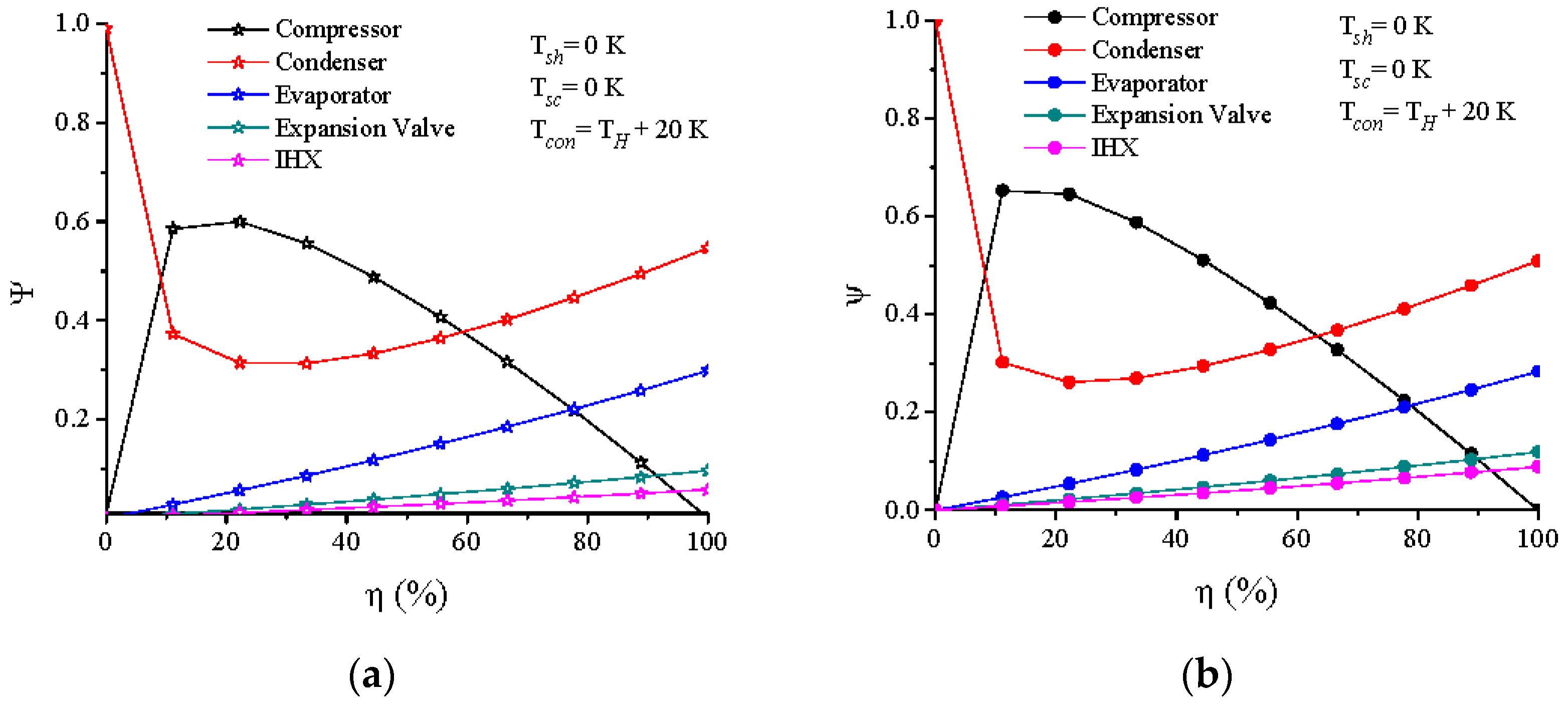
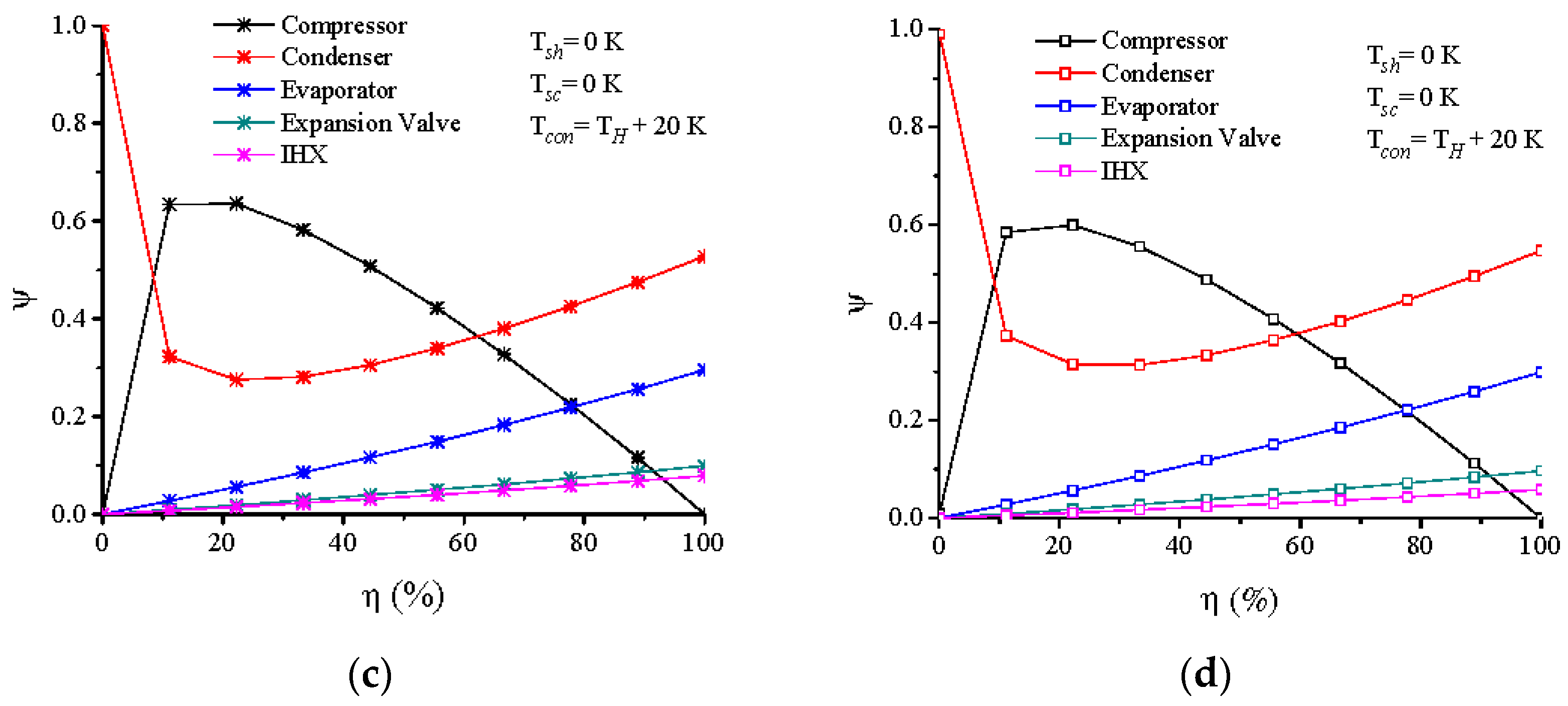
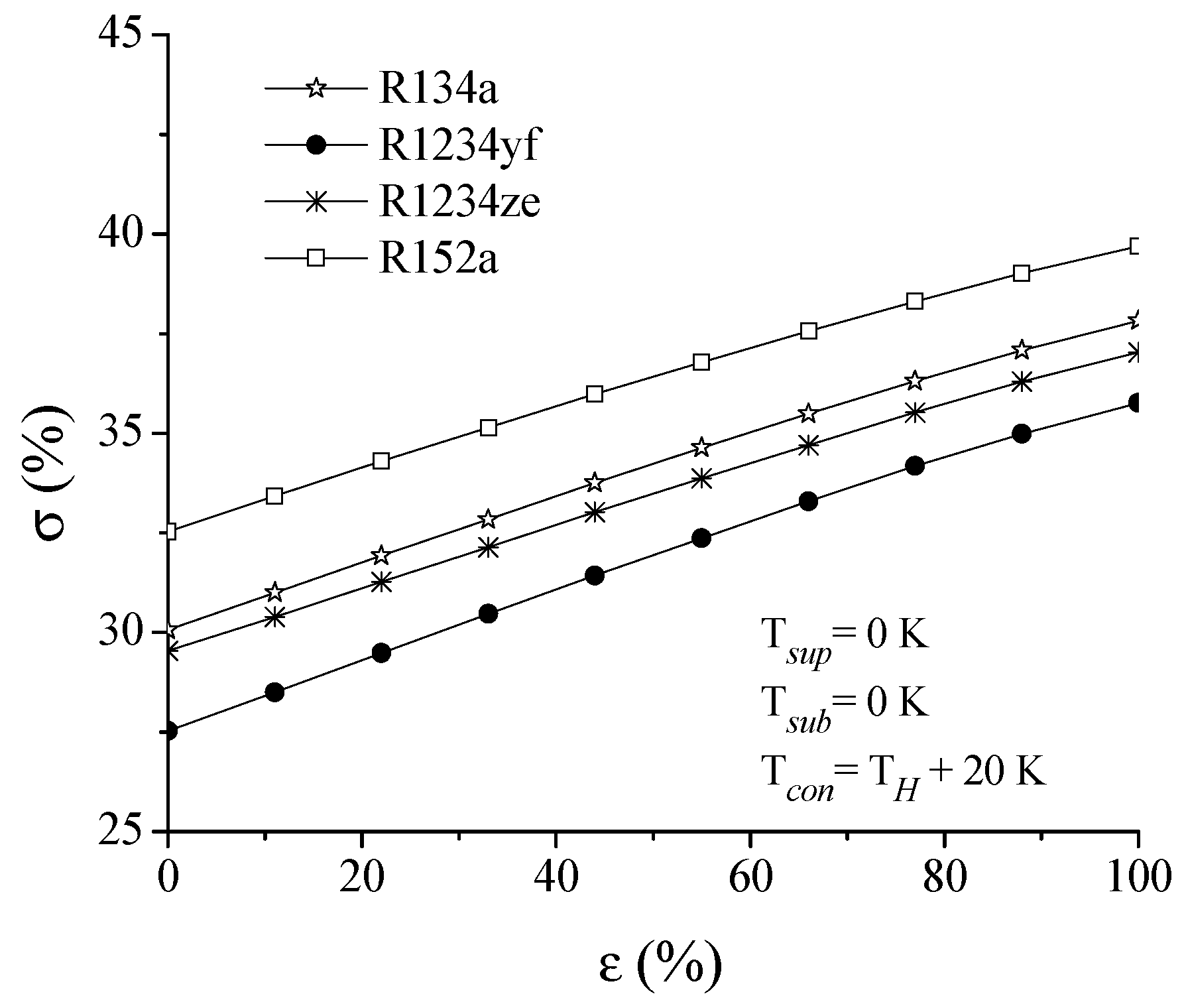
| Item | Value |
|---|---|
| Evaporation temperature, Tev | 282.95 |
| Condensation temperature, Tcon | 327.15 |
| Indoor temperature, TL | 296.15 |
| Outdoor temperature, TH | 307.15 |
| Isentropic efficiency, | 75% |
| Item | Equations |
|---|---|
 Compressor | |
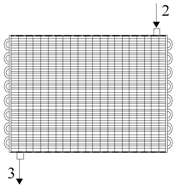 Condenser | |
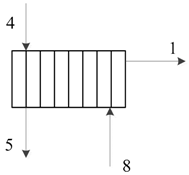 IHX | |
 Expansion valve | |
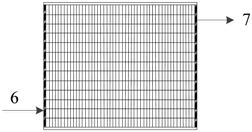 Evaporator |
© 2017 by the authors. Licensee MDPI, Basel, Switzerland. This article is an open access article distributed under the terms and conditions of the Creative Commons Attribution (CC BY) license (http://creativecommons.org/licenses/by/4.0/).
Share and Cite
Pérez-García, V.; Belman-Flores, J.M.; Rodríguez-Muñoz, J.L.; Rangel-Hernández, V.H.; Gallegos-Muñoz, A. Second Law Analysis of a Mobile Air Conditioning System with Internal Heat Exchanger Using Low GWP Refrigerants. Entropy 2017, 19, 175. https://doi.org/10.3390/e19040175
Pérez-García V, Belman-Flores JM, Rodríguez-Muñoz JL, Rangel-Hernández VH, Gallegos-Muñoz A. Second Law Analysis of a Mobile Air Conditioning System with Internal Heat Exchanger Using Low GWP Refrigerants. Entropy. 2017; 19(4):175. https://doi.org/10.3390/e19040175
Chicago/Turabian StylePérez-García, Vicente, Juan M. Belman-Flores, José L. Rodríguez-Muñoz, Víctor. H. Rangel-Hernández, and Armando Gallegos-Muñoz. 2017. "Second Law Analysis of a Mobile Air Conditioning System with Internal Heat Exchanger Using Low GWP Refrigerants" Entropy 19, no. 4: 175. https://doi.org/10.3390/e19040175
APA StylePérez-García, V., Belman-Flores, J. M., Rodríguez-Muñoz, J. L., Rangel-Hernández, V. H., & Gallegos-Muñoz, A. (2017). Second Law Analysis of a Mobile Air Conditioning System with Internal Heat Exchanger Using Low GWP Refrigerants. Entropy, 19(4), 175. https://doi.org/10.3390/e19040175








